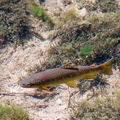Ecological impoverishment of rivers
TUM scientists record species decline at weirs
09.09.2011, Press releases
Dams and weirs have a stronger impact on the ecosystem of watercourses than was previously realized. Species diversity in the dammed area upstream of weirs shows a significant decline: the diversity of fish species is one-quarter lower on average, and species diversity among invertebrates is up to 50 percent lower. The interruption of a river course thus has greater effects on the biodiversity than the geological origin of the river itself. Scientists from the Technische Universität München (TUM) have demonstrated this on the basis of a survey of five rivers in the catchment areas of the Elbe, Rhine/Main, and Danube. Their analysis records, for the first time, both abiotic factors, for example chemical composition, current, and river bed substrate, and biotic factors, such as the number, size, and diversity of all important animal and plant groups on the two sides of weirs. The TUM researchers will present their findings, which have already been published online in the Journal of Applied Ecology, at the annual conference of the German Limnological Society, which takes place from September 12 to 16, 2011.
Whether it is done for the generation of electricity,
for flood protection, or collection of drinking-water, the damming of a river
represents a drastic intervention in its ecosystem. Weirs and dams alter the chemical
and physical characteristics of the water and the riverbed. Their construction
is accompanied by a clear decline in upstream species diversity, and this is
exacerbated by successive damming. This phenomenon, which is known as “serial
discontinuity", has now been measured for all important animal and plant
groups by system biologists from the TUM for the first time; the information
available up to now concerned only individual taxonomic groups or species. The
scientists carried out a systematic survey of the aquatic organisms on both
sides of the weirs in five rivers of different geological origins. Their survey
revealed a significant reduction in the number, biomass and variety of periphyton, invertebrates, and fish species upstream
of the weirs. Compared with downstream areas, the diversity of fish species
measured upstream of weirs was 25 percent lower on average; a threefold decline
in biomass was also observed.
Current-loving fish species,
many of which are on the "Red List" of endangered species, are
particularly severely affected. “Brown trout, grayling and Danube salmon are demanding
fish species that require oxygen-rich water and spawn in coarse gravel areas.
As typical residents of the upper reaches of rivers, they are unable to find
suitable habitats in dammed areas”, explains Jürgen Geist, Professor of Aquatic
Systems Biology at TUM. “These river sections are often dominated instead by
bream, chub, and even carp – generalist species that are actually adapted to stagnant
waters. The ecological impoverishment of rivers is particularly dramatic when
series of dams prevent the sufficient interlinking of different habitat types”,
says Geist. According to the Bayerische Landesamt für Umwelt (Bavarian
Environmental Agency) there are more than 10,000 weirs in Bavaria’s rivers
alone.
According to the
researchers, the main reason for the species decline is not the impermeability
of the barrier to migrating fish species. Instead, the deciding factor is the chemical
and physical alteration of the river itself which leads to a reduction of
biodiversity. If the current is decelerated or interrupted, the flow rate
upstream of the weir declines, and this is accompanied by increased water depth.
In all of the surveyed dammed areas, the TUM scientists also recorded major
differences in the oxygen content and temperature of the water and the sediment
in the river bed, which hinders reproduction in current-loving fish species. The
situation is compounded by differences in the structure of the sediments. The
particles in the sediment found downstream of weirs are twice as large on
average as those upstream, providing more and better quality spawning grounds.
River sections in the direct
proximity of weirs should, therefore, be given greater consideration in
ecological quality assessments, notes Prof. Geist: “During the evaluation of
new weirs or modernization of hydroelectric power plants, attention should no
longer be focused exclusively on the migration of fish species, but on the consequences
of the structure and function for the river ecosystem as a whole.” To ensure
this, affected river sections must be covered by the relevant laws or
regulations, such as the European Union Water Framework Directive. “A set of
instruments for the quantification of the effects of weirs is now available, which
records both the quality of the habitat and its biodiversity”, says the TUM
scientist.
Publication:
M. Müller, J. Pander, J. Geist:
The effects of weirs on structural stream habitat and biological communities,
Journal of Applied Ecology (early online)
Contact:
Prof. Jürgen Geist
Aquatic Systems Biology
Technische
Universität München
Telephone:
+ 49 (0)8161 71 3767
E-Mail:
geist@wzw.tum.de
More information:
Annual conference of the German Limnological Society,
September 12-16, 2011
http://www.dgl2011.de/
Innovative small-scale hydroelectric power plant: Shaft power plant
designed by the Department of Hydraulic and Water
Resources Engineering TUM
http://portal.mytum.de/pressestelle/pressemitteilungen/news_article.2010-10-19.2049821025
Kontakt: presse@tum.de
More Information
| Biodiversitaet.pdf |
Druckversion dieser Presseinformation,
(Type: application/pdf,
Size: 71.7 kB)
Save attachment
|
|
| Effects_of_weirs_on_biodiversity.pdf |
Print version of this article,
(Type: application/pdf,
Size: 110.6 kB)
Save attachment
|




